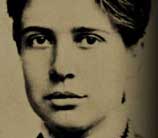 Alice Davis Sing, click to view case details.
Alice Davis Sing, click to view case details.
Killings in revenge or from passion occur throughout this set of cases. Each is the remnant of a feud or complicated story, whose circumstances are only hinted at in the records here. Additional research in contemporaneous sources might begin to untangle some of the history which preceded the homicide.
Cases such as these remind the reader that each record of a case is potentially the beginning of a journey leading to information, not just about the complicated set of social interactions which preceded the murder, but the story of how those events were treated by official actors, as the crime became a case in the legal system. This type of case is another reminder that homicide is a social event, an interaction between people who have a previous relationship. Records in the county and state archives contain original accounts, and documents regarding professional representation. Newspaper reports also provide valuable contextual information. See, as an example of how a simple factual description of a crime can be amplified, the amount of detail discovered regarding another case (Thomas F. Geraghty Article).
Further information on these and other cases can be found in the Illinois State Archives, Norton Building, Capital Complex, Springfield Il. 62756, tel: (217) 782 4582, fax: (217) 524-3930. The records in the Illinois State Archives includes birth and death certificates, Cook County Coroner’s Inquest Record Index, 1872-1911, Supreme Court Reports, and many other official reports, notes, legal records and data sources, including a microfilm copy of the original handwritten records of this data set, and many other rich historical resources.
In addition, there are the Cook County Coroner’s Inquest Records, 1872- 1911, Illinois Regional Archives Depository Northeastern Illinois University, Chicago, Illinois. These public records, which contain the verdict of the coroner’s jury, the names of the jurors, the witnesses’ names and occupations, are available on microfilm at the depository. The records are indexed by the name of the deceased and date of death. The Illinois Regional Archives Depository lists the available corner’s records as: Coroner’s Inquest Records 1872-1911, 52 reels of microfilm: “Records shows the date and location of the coroner’s inquest; the name, residence, and occupation of the deceased; the names of the jurors; the names, residences, and occupations of the witnesses; the testimony of the witnesses about the circumstances of the death; a description of the deceased; the jury’s verdict on the cause of death; and acknowledgment by the coroner.” In cases which captured the attention of the public, the decision by the Coroner’s jury was also likely to be reported in the local newspapers.
For further reading: Baldasty, Gerald J., The Commercialization of News in the Nineteenth Century. Madison: University of Wisconsin Press, 1992. A history of newspapers and the changing environment in the reporting of news and political issues in the nineteenth century, including excellent appendices, notes and an extended bibliography.
Emery, Michael and Edwin Emery, The Press and America – An Interpretative History of the Mass Media. Englewood Cliffs: Prentice Hallo, 1992.
Nord, David Paul, Newspapers and New Politics: Midwestern Municipal Reform. Ann Arbor: University of Michigan Press, 1979. A comparison of urban reform efforts in Chicago and St. Louis in 1890-1900, using contemporaneous newspaper accounts. Ch.5.
